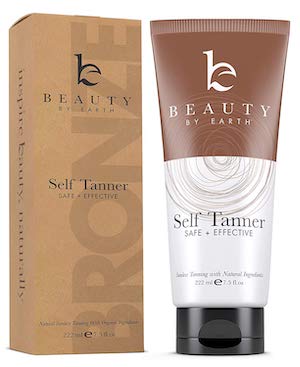A self-tanning product is the best alternative to sunbathing. It gives you a natural-looking sun-kissed skin without dealing with the harmful UV rays. It saves you from blotches, sunburn, and other skin problems caused by the sun. But here’s one drawback of self-tanner: it only lasts for a few days.
Many brands suggest reapplication, but how often do you have to apply self-tanner? I recommend applying self-tanner once or twice every month, depending on the product you’re using and how tan you want to get. If you want to maintain a tan all-year-round, then using a gradual tanner is your best option.
Keep reading for my best advice for a self-tanning schedule.
How Often to Apply Self-Tanner – Things To Consider
Below are the three most important things to consider when deciding how often to apply self-tanner on yourself.
The skin structure
The skin is composed of two major layers: the dermis which is the innermost layer, and the epidermis which is the outermost layer.
The epidermis is also made up of two layers: the stratum basale, the deepest layer which is affected during sunbathing, and the stratum corneum, the outermost layer which is affected by self-tanning products.
Read the label
Self-tanners react to the dead skin cells found on the outermost layer of the skin. Every day, the skin sloughs off dead skin cells and every 35-45 days, a new epidermis is formed.
As the dead skin cells to slough off, so does the self-tanned skin. For this reason, many self-tanner labels recommend the reapplication of the product every 3-5 days or so to keep your skin tan.
If you get a high-quality self-tanner you’ll have to reapply it less often and it will fade much more naturally. In fact, I’ve tried literally over 100 different self-tanning products, and nothing has worked as well as this one that I found on Amazon.
What the experts say
Self-tanners contain dihydroxyacetone (DHA), the active ingredient that reacts to the dead skin cells and causes the tanned effect. The tan is temporary and wears off after a few days, usually 7 to 10 days.
There is no proof that DHA has negative effects on health. Self-tanners have the right amount of the DHA and this amount is considered non-toxic and non-carcinogenic.
Dermatologists do not disagree with the reapplication of self-tanners. Users may apply it as often as the skin sheds dead skin cells. However, it is worth noting that excessive amounts of DHA may cause free radicals which can damage cells.
The primary concern of health professionals is the possible inhalation and ingestion of self-tanning products. Doing so is not advisable. Therefore, they recommend wearing protective gear such as a mask, gloves, and lip balms to keep the product from the eyes, nose, lips, and mucous membranes.
How do you properly apply a self-tanner?
To ensure the safe and effective application of self-tanners, here are some basic tips:
- Exfoliate the skin.
- With a damp washcloth and exfoliating products, remove excess dead skin cells. Pay more attention to elbows, knees, and ankles where the skin is the thickest. After exfoliating, dry your skin to make sure self-tanning product will be spread evenly. Do this before applying any self-tanning product.
- Do everything you need to do before applying self-tanner.
- These include waxing, shaving, etc. These treatments can remove the self-tanner which is not what you want.
- Apply the self-tanner in sections.
- Pay attention to one section of the body, for example, the leg, when applying the self-tanner. Then apply it to the next section. Apply the tanner in a circular motion.
- Wash your hands after applying the self-tanning to each body section.
- This is to prevent discoloration of your hands. Wash them with soap and water.
- The knees, elbows, and ankles absorb more self-tanner than other sections.
- Therefore, you must dilute these areas using a damp towel on the self-tanner.
- Be careful when applying self-tanner to the face, as mistakes are much more difficult to hide.
- Check out my guide on applying sunless tanner to the face for a step by step guide.
- Self-tanners take at least 10 minutes to dry and 3 to 5 hours to take effect.
- During these times, avoid getting sweaty, and wear loose clothes during this time.
- Many users think that self-tanners contain sunscreen, which is not true.
- You still need to further protect your skin from harmful UV rays. Apply appropriate sunscreen according to the length of hours you plan to spend time outdoors.
What to look for in self-tanning products
When purchasing a self-tanning product, consider the following:
- Gradual tan—Determine if the self-tanner creates tan overnight or gradually builds up tan when applied every day
- Tinting formula—A self-tanner with tinting formula lets you determine the evenness of the tan while applying. Without this formula, you can’t see the amount of self-tanner you directly apply to your skin
- Self-tanners usually have a very mild scent or no scent at all. Fake self-tanners can be identified by having a strong odor that lingers on the skin and clothes

